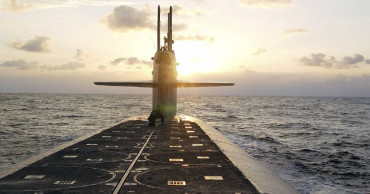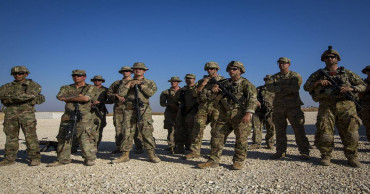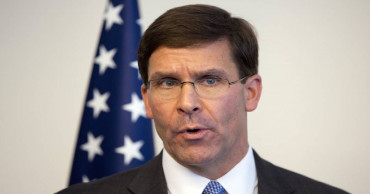U.S. military
Last Afghan refugees leave NJ base after chaotic evacuation
The last of thousands of Afghan refugees who awaited resettlement at eight U.S. military installations departed Saturday from a base in New Jersey, completing a journey that started with the chaotic evacuation from Kabul in August.
With assistance from refugee resettlement organizations, Afghans evacuated after their country fell to the Taliban have been gradually leaving the military bases in recent months and starting new lives in communities throughout the United States.
The U.S. admitted 76,000 Afghans as part of Operation Allies Welcome, the largest resettlement of refugees in the country in decades.
“It’s a really important milestone in Operation Allies Welcome but I want to stress that this mission isn’t over,” said Krish O’Mara Vignarajah, president and CEO of Lutheran Immigration and Refugee Service, one of nine national resettlement organizations that were part of the effort.
READ: Afghans protest US order to give $3.5B to 9/11 victims
Afghans still in their country but facing danger under Taliban rule as well as those who have made it to the United States will still need assistance, Vignarajah said.
“Successful resettlement and integration won’t happen in just a matter of days or weeks,” she said. “Our new Afghan neighbors are going to need our support and friendship for months and years to come because the challenges they face won’t disappear overnight.”
The U.S. plans to admit thousands of Afghan refugees over the next year but they will arrive in smaller groups and will be housed in a facility at a location yet to be determined, the Department of Homeland Security said.
Housing facilities for refugees at Joint Base McGuire-Dix-Lakehurst in central New Jersey will remain open in the interim, the agency said. The base held the largest number of Afghans, reaching a peak of 14,500. The next largest was at Fort McCoy in Wisconsin, where the last group departed this past week.
Afghans underwent immigration processing and health screening while they waited at the bases, often for months, until the strained refugee organizations could place them in communities. The government set up schools for the children who made up about 40 percent of the refugees at the New Jersey base.
Resettlement organizations and Homeland Security, the lead federal agency in the effort, had set a goal of having everyone off the bases by Feb. 15. It was a challenge because of the scarcity of affordable housing, cutbacks to refugee programs under President Donald Trump and the sheer number of refugees.
Most of the refugees have settled in established Afghan communities in northern Virginia and the surrounding Washington area, as well as Northern California and Texas.
States where between 1,000 and 3,000 have settled include Arizona, New York, Florida, Georgia, Colorado, Nebraska and Pennsylvania, according to State Department data obtained by The Associated Press.
DHS has previously said about 40 percent of the Afghans will qualify for the special immigrant visa for people who worked as military interpreters or for the U.S. government in some other capacity during America’s longest war.
Most of the rest, however, do not yet have permanent legal residency in the U.S. because they did not come under a refugee program but were admitted under a type of emergency federal authorization known as humanitarian parole.
Advocates for the refugees, including a number of prominent veterans groups, are pressing Congress to provide permanent residency with an “Afghan adjustment act,” similar to what has been done in the past for Cubans and Iraqis.
3 years ago
Race on to evacuate 22,000 Afghans by Aug. 31 deadline
In a perfect world, according to American defense officials, U.S. military aircraft would be able to get 5,000 Afghans out of the Kabul airport each day. But perfect is the furthest thing from the conditions on the ground in Afghanistan right now.
After flights were grounded most of Monday to allow troops to corral a crowd of desperate Afghans who’d stormed the airport hoping to board C-17 Globemasters, the Pentagon confirmed in the early evening that flights had resumed and that they are working on the logistics to get as many as 22,000 Afghan interpreters, their families and other vulnerable Afghans into the U.S. ― by Aug. 31, reported US military's media outlet Military Times.
“Over the next two weeks, we’re going to be as aggressive as we can in moving as many people as we can,” Pentagon spokesman John Kirby told Military Times. “That’s seats on airplanes, not just military airplanes, but commercial and charter airplanes as well.”
For now, C-17s arriving to drop off troops are loading up with embassy personnel, other American citizens and Afghan special immigrant visa applicants, moving to one of a small handful of partner countries who have agreed to be way stations. So far, Qatar is the only confirmed location.
With the airport now under control, all estimated 22,000 people could be out in a week. If it takes longer than that, officials couldn’t confirm whether the mission would be extended into September.
President Joe Biden said in an address Monday that the U.S. delayed SIV evacuations so as not to create a panic in the country.
“Some of the Afghans did not want to leave earlier, still hopeful for their country,” he said. “It was also in part because the Afghan government and its supporters discouraged us from organizing a mass exodus, to avoid triggering, as they said, a crisis of confidence.”
The Afghanistan crisis action group stood up in July, at the State Department’s behest, more than two months after President Joe Biden announced in April the full withdrawal of troops from Afghanistan by the end of the summer. Almost immediately, Americans and Afghans alike wanted to know the exit plan for locals who had risked their lives to help U.S. troops.
They didn’t get their answer until late July, when State announced that 4,000 Afghans would be flown to a third country to complete their security screenings, while 750 would go straight to Fort Lee, Virginia, to do their final medical screenings before receiving their special immigrant visas.
Roughly 2,000 of those have made it to the U.S. since. On Monday, the Pentagon confirmed that Fort Bliss, Texas, and Fort McCoy, Wisconsin, would be opened up to temporarily house incoming refugees, with the capacity to take in up to 22,000 before the end of the month.
READ: ‘Will remain alert,' says FM about Afghan-trained terrorists
The action group will “continue to do everything in this department to continue this process,” Garry Reid, the group’s lead, told Military Times, up to and past the deadline, if that’s called for.
“We’re going to stay in this as long as it takes, as long as we can contribute,” he said.
But Kirby reiterated that Aug. 31 is still the deadline, and that 22,000 is more of a ceiling than a known head count.
“It doesn’t mean that there are going to be 22,000 people that need that support,” he said.
Weeks ago, when those evacuations began, the Taliban was rapidly conquering provincial capitals, but there was still a chance that SIVs not located in Kabul would be able to get themselves to the capital and to the airport to be processed. Now, the chances are more slim than ever.
When reinforcements have all arrived, there will be roughly 7,000 U.S. troops securing the Kabul airport, and their mission so far is confined there, Kirby said, with no plans currently to help escort anyone to the airport.
So while State has roughly 18,000 known applicants, and DoD is prepared to take in even more, the real determining factor will be whether these Afghans can make it safely to Hamid Karzai International.
READ: Pakistan, U.S. speak on Afghanistan's future
As for whether the security mission there could go past August, in an effort to evacuate as many as possible, Kirby could not say definitively.
“Beyond Aug. 31, it’s just too difficult to speculate, and we wouldn’t get ahead of decisions that are yet to be made,” he said.
4 years ago
US vacates key Afghan base; pullout target now 'late August'
Nearly 20 years after invading Afghanistan to oust the Taliban and hunt down al-Qaida, the U.S. military has vacated its biggest airfield in the country, advancing a final withdrawal that the Pentagon says will be completed by the end of August.
President Joe Biden had instructed the Pentagon to complete the military withdrawal by Sept. 11, the 20th anniversary of the terrorist attacks on the United States, but the Pentagon now says it can finish the drawdown a little earlier. In fact, the drawdown is already largely completed and officials had said it could be wrapped up this weekend. But a number of related issues need to be worked out in coming weeks, including a new U.S. military command structure in Kabul and talks with Turkey on an arrangement for maintaining security at the Kabul airport, and so an official end to the pullout will not be announced soon.
READ: US hands Bagram Airfield to Afghans after nearly 20 years
“A safe, orderly drawdown enables us to maintain an ongoing diplomatic presence, support the Afghan people and the government, and prevent Afghanistan from once again becoming a safe haven for terrorists that threatens our homeland,” Pentagon press secretary John Kirby said.
The administration is meanwhile narrowing options for ensuring the safety of thousands of Afghans whose applications for special visas to come to the United States have yet to be approved. The administration has already said it’s willing to evacuate them to third countries pending their visa approvals but has yet to determine where. Officials said Friday that one possibility is to relocate them to neighboring countries in Central Asia where they could be protected from possible retaliation by the Taliban or other groups.
The White House and State Department have declined to comment on the numbers to be relocated or where they might go, but the foreign ministers of Tajikistan and Uzbekistan were both in Washington this week and the subject of Afghan security was raised in meetings they held with Secretary of State Antony Blinken and Defense Secretary Lloyd Austin.
Kirby said that Austin on Friday approved a new command structure in Afghanistan to transition the U.S. military mission from warfighting to two new objectives — protecting a continuing U.S. diplomatic presence in Kabul and maintaining liaison with the Afghan military.
Austin’s plan calls for the top commander in Afghanistan, Army Gen. Scott Miller, to transfer his combat authorities to the Florida-based head of U.S. Central Command, Marine Gen. Frank McKenzie, before relinquishing his command this month. Also, a two-star Navy admiral will head a U.S. Embassy-based military office, dubbed U.S. Forces Afghanistan-Forward, to oversee the new mission of providing security for the embassy and its diplomats.A satellite military office based in Qatar and headed by a U.S. one-star general will be established to administer U.S. financial support for the Afghan military and police, plus maintenance support provided for Afghan aircraft from outside Afghanistan.
Kirby said Miller, who already is the longest-serving commander of U.S. forces in Afghanistan in the 20 years of warfare, will remain in command for “a couple of weeks” longer but was not more specific. He said Miller will be preparing for and completing the turnover of his duties to McKenzie and also will be traveling inside and beyond Afghanistan.
Miller met Afghan President Ashraf Ghani on Friday and, according to a Dari-language tweet by the presidential palace, the two discussed “continued U.S. assistance and cooperation with Afghanistan, particularly in supporting the defense and security forces.”
READ: Biden vows 'sustained' help as Afghanistan drawdown nears
Bagram Airfield has been the epicenter of the war to oust the Taliban and hunt down the al-Qaida perpetrators of the 9/11 terrorist attacks on America. At its peak in and around 2012, Bagram Airfield saw more than 100,000 U.S. troops pass through the massive compound barely an hour’s drive north of Kabul.
Meanwhile, Afghanistan’s district administrator for Bagram, Darwaish Raufi, said the American departure was done overnight without any coordination with local officials, and as a result early Friday, dozens of local looters stormed through the unprotected gates before Afghan forces regained control.
“They were stopped and some have been arrested and the rest have been cleared from the base,” Raufi told The Associated Press, adding that the looters ransacked several buildings before being arrested and the Afghan forces took control.
However, U.S. military spokesman Col. Sonny Leggett said the handover was an “extensive process” that spanned several weeks and began soon after Biden’s mid-April announcement that America was withdrawing the last of its forces.
“All handovers of Resolute Support bases and facilities, to include Bagram Airfield, have been closely coordinated, both with senior leaders from the government and with our Afghan partners in the security forces, including leadership of the locally based units respective to each base,” said Col. Leggett.
The Taliban welcomed the American withdrawal from Bagram Airfield. Taliban spokesman Zabihullah Mujahid tweeted that Friday’s departure was a “positive step,” urging for the “withdrawal of foreign forces from all parts of the country.”
As of this week, most other NATO soldiers have already quietly exited Afghanistan. Announcements from several countries analyzed by the AP show that a majority of European troops has left with little ceremony — a stark contrast to the dramatic and public show of force and unity when NATO allies lined up to back the U.S. invasion in 2001.
READ: Taliban gains drive Afghan government to recruit militias
The U.S. has refused to say when the last American soldier would leave Afghanistan, citing security concerns, but also future security and protection for Kabul International Airport is still being negotiated. Turkish and U.S. soldiers are currently protecting the airport, still under Resolute Support Mission, which is the military mission being wound down.
Until a new agreement for the airport is struck by Turkey and the Afghan government, and possibly the United States, it appears the Resolute Support mission would to have to continue to be in charge of the facility.
4 years ago
US bomber mission over Persian Gulf aimed at cautioning Iran
The United States flew strategic bombers over the Persian Gulf on Wednesday for the second time this month, a show of force meant to deter Iran from attacking American or allied targets in the Middle East.
4 years ago
US starts troop pullout, seeks end to Afghan leaders' feud
The United States began withdrawing troops from Afghanistan, the U.S. military said Tuesday, taking a step forward on its peace deal with the Taliban while also praising Afghan President Ashraf Ghani's promise to start releasing Taliban prisoners after he had delayed for over a week.
5 years ago
Trump says U.S. working to end Afghan war
U.S. President Donald Trump said here on Tuesday night in his State of the Union address that his administration is working to end the war in Afghanistan.
5 years ago
US adds 'low yield' nuclear weapon to its submarine arsenal
The U.S. military has deployed a new addition to its nuclear arsenal — a long-range missile armed with a nuclear warhead of reduced destructive power. The so-called low-yield missile joins other, more powerful weapons aboard stealthy submarines prowling the oceans.
5 years ago
Iran uses violence, politics to try to push US out of Iraq
Iran has long sought the withdrawal of American forces from neighboring Iraq, but the U.S. killing of an Iranian general and an Iraqi militia commander in Baghdad has added new impetus to the effort, stoking anti-American feelings that Tehran hopes to exploit to help realize the goal.
5 years ago
US has made no decision to leave Iraq, says Defense Secretary Esper
Defense Secretary Mark T. Esper said Monday that the United States has not made any decision to leave Iraq, shortly after the U.S. military said in a letter to Iraqi officials that U.S. forces would be relocating “to prepare for onward movement”, reports The Washington Post.
5 years ago
Trump grants clemency to U.S. military officers involved in war crimes
U.S. President Donald Trump has granted clemency to two Army officers accused or convicted of war crimes in Afghanistan as well as a Navy SEAL convicted of posing for a photo with a dead Islamic State (IS) fighter, the White House announced on Friday.
6 years ago
.jpg)
.jpg)
.jpg)

.jpg)







